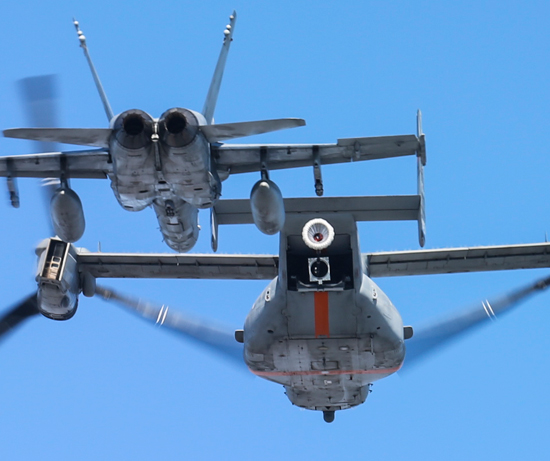
The Bell-Boeing MV-22 Osprey tilt-rotor aircraft has successfully completed an initial test performing as an aerial refueling tanker. Adding this capability to the tiltrotor aircraft would further advance its versatility in support of Marine corps and naval aviation operations, as well as special operations in naval, combat, humanitarian and ship-based operations. In August 2013 the aircraft flew several demonstration flights over north Texas, with a V-22 equipped with a prototype aerial refueling system safely deployed, held stable, and retracted the refueling drogue as an F/A-18C and an F/A-18D Hornet flew just behind and to the side of the aircraft. According to the test data, on the fourth mission the Hornets flew within 30 ft. of the MV-22’s drogue chute in a lateral offset position.
“Adding aerial refueling tanker capability to the V-22 will enable operators to execute a wider variety of missions with greater flexibility and autonomy,” said Vince Tobin, Bell Boeing V-22 program director. “This will save time and money by maximizing the efficient use of aircraft and personnel.” Future Bell Boeing tests will put aircraft in a fuel-receiving position directly behind the V-22, connect receiver aircraft with the refueling drogue and, ultimately, refuel a variety of aircraft in flight. The V-22 is a combat-proven tiltrotor that can fly horizontally at high speeds and high altitudes like an airplane, and take off and land vertically like a helicopter.
Currently the Marine Corps are employing C-130H/J for aerial refueling missions, flown from land-bound bases. Helicopters such as the CH-53 can refuel from the C-130 but are not suitable to refuel other aircraft, particularly fast jets. As a tilt-rotor that can cruise at much higher speed than a helicopter, the Osprey can maintain a high speed cruise that could be synched with jet fighters, flying at relatively low speed, maintaining safe and stable flight for refueling purposes. The use of MV-22 as a refueling aircraft is part of a Bell/Boeing plan to propose a substitute to the US Navy C-2 aircraft. The Greyhound Carrier Onboard Delivery (COD) aircraft built by Northrop Grumman is used as utility transport and carrier replenishment missions.
The U.S. Navy has yet to decide whether to replace the 48 Greyhounds it currently operate, or extend their life. While the V-22 would cost more, it would offer the advantage of a common platform supporting aircraft carriers (CVN) and amphibious landing ships (LHD), as well as performing other missions such as Search and Rescue (SAR), troop transport and other missions. The U.S. Marine Corps is the primary customer for the MV-22 with a program of 360 aircraft, with the U.S. Air Force also buying 50 of the aircraft to replace its retired MH-53s.























